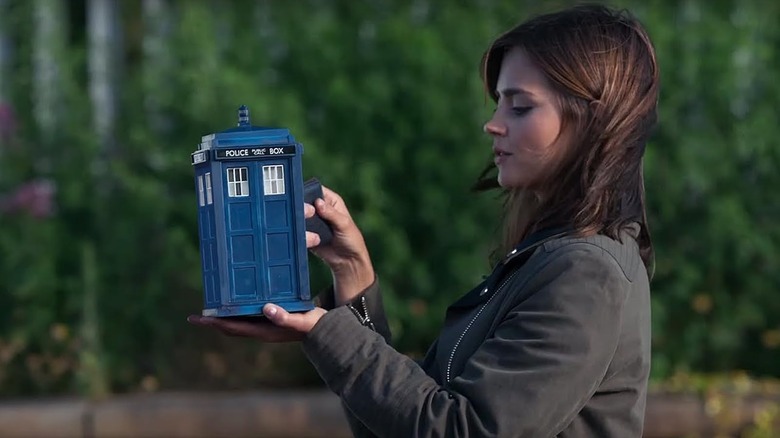What Does TARDIS Stand For In Doctor Who?
"Doctor Who" is a series that thrives on change, so much so that not even its two main characters — the Doctor and their companion — can be depended on to stick around for the next season. Even little things fans might take for granted, like the basic shape of the Doctor's sonic screwdriver or the general notion of the Doctor keeping a consistent outfit, can be casually tossed aside at a moment's notice.
The only true constant is the TARDIS, the Doctor's trusty blue box that travels through time and space and is somehow bigger on the inside. Appropriately, the term "TARDIS" itself stands for "Time And Relative Dimension In Space." It's a term that was supposedly coined by the Doctor's first companion Susan (Carole Ann Ford), but all the Time Lords we'd later see in the show would refer to their time machines by the same name. I guess Susan's nickname caught on fast! (The serious answer here is that it took a while for the "Doctor Who" writers to figure things out in the early seasons, so there are a lot of minor inconsistencies like this.)
Although the TARDIS can easily travel through time and space, the one thing it can't do is change its outside appearance from a police telephone box. This design, which the Doctor intended as a temporary feature to help the vessel blend into 1960s Britain, ended up stuck like that. Even though the '60s police box no longer blends in with its surroundings at all, the Doctor has never bothered to fix the problem. Luckily, the box has an invisibility feature the Doctor occasionally uses, as well as a continuous perception filter that helps it avoid the attention of most passersby.
Another key bit of info about the TARDIS: the machine has a built-in translation feature for anyone who travels on it. This is why almost every new character the show introduces speaks perfect English, even when they probably shouldn't be speaking any human language at all.
The outside of the Tardis has stayed consistent, but its inside hasn't
Whereas the Doctor changes on the outside with each reincarnation, the TARDIS has a tendency to regularly reinvent its interior. Sometimes, the inside of the TARDIS has dark, cold lighting, and sometimes it's brightly lit like something out of a fairy tale. There've been a lot of TARDIS interiors over the years, and most of them tell the audience something important about what sort of mood the current Doctor is in. For instance, when the 11th Doctor unveils his cold blue Tardis interior in "The Snowmen," it helps to show that this Doctor is grieving.
If there's one thing that connects all the different TARDIS interiors (well, all the good ones at least), it's that they're created with a ton of intentionality. In fact, ever since William Hartnell, the first actor to play the Doctor, made sure to stay consistent about what each little button on the console actually does (which itself, amusingly enough, wasn't the "Doctor Who" rule Ncuti Gatwa got in trouble for breaking), every new TARDIS interior has been designed to be true to both the old ones and the current Doctor's general flavor.
When crafting the first TARDIS for the "Doctor Who" revival in 2005, production designer Edward Thomas continued the tradition by putting a ton of thought into what Christopher Eccleston's ninth Doctor (and then, later, David Tennant's 10th Doctor) would want their TARDIS interiors to look like. "I wanted to create a time machine that, being 700 years old, there was very little of the original structure left because the Doctor would have had to have continually updated it and fixed it," he explained in a season 1 behind-the-scenes video. "It's a sort of an amalgamation of old and new."

